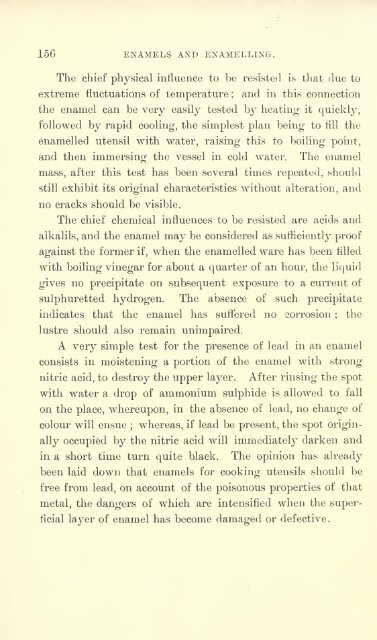Enamels and enamelling; an introduction to the preparation and ...
Enamels and enamelling; an introduction to the preparation and ...
Enamels and enamelling; an introduction to the preparation and ...
You also want an ePaper? Increase the reach of your titles
YUMPU automatically turns print PDFs into web optimized ePapers that Google loves.
156 ENAMELS AND ENAMELLING.<br />
The chief physical influence <strong>to</strong> be resisted is that due <strong>to</strong><br />
extreme fluctuations of temperature ; <strong><strong>an</strong>d</strong> in this connection<br />
<strong>the</strong> enamel c<strong>an</strong> be very easily tested by heating it quickly,<br />
followed by rapid cooling, <strong>the</strong> simplest pl<strong>an</strong> being- <strong>to</strong> fill <strong>the</strong><br />
enamelled utensil with water, raising this <strong>to</strong> boiling point,<br />
<strong><strong>an</strong>d</strong> <strong>the</strong>n immersing <strong>the</strong> vessel in cold water. The enamel<br />
mass, after this test has been several times repeated, should<br />
still exhibit its original characteristics without alteration, <strong><strong>an</strong>d</strong><br />
no cracks should be visible.<br />
The chief chemical influences <strong>to</strong> be resisted are acids <strong><strong>an</strong>d</strong><br />
alkalils, <strong><strong>an</strong>d</strong> <strong>the</strong> enamel may be considered as sufficiently proof<br />
against <strong>the</strong> former if, when <strong>the</strong> enamelled ware has been filled<br />
with boiling vinegar for about a quarter of <strong>an</strong> hour, <strong>the</strong> liquid<br />
gives no precipitate on subsequent exposure<br />
<strong>to</strong> a current of<br />
sulphuretted hydrogen. The absence of such precipitate<br />
indicates that <strong>the</strong> enamel has suffered no corrosion ; <strong>the</strong><br />
lustre should also remain unimpaired.<br />
A very simple test for <strong>the</strong> presence of lead in <strong>an</strong> enamel<br />
consists in moistening a portion of <strong>the</strong> enamel with strong<br />
nitric acid, <strong>to</strong> destroy <strong>the</strong> upper layer.<br />
After rinsing <strong>the</strong> spot<br />
with water a drop of ammonium sulphide is allowed <strong>to</strong> fall<br />
on <strong>the</strong> place, whereupon, in <strong>the</strong> absence of lead, no ch<strong>an</strong>ge of<br />
colour will ensue ;<br />
whereas, if lead be present, <strong>the</strong> spot originally<br />
occupied by <strong>the</strong> nitric acid will immediately darken <strong><strong>an</strong>d</strong><br />
in a short time turn quite black. The opinion has already<br />
been laid down that enamels for cooking utensils should be<br />
free from lead, on account of <strong>the</strong> poisonous properties of that<br />
metal, <strong>the</strong> d<strong>an</strong>gers of which are intensified when <strong>the</strong> super-<br />
ficial layer of enamel has become damaged or defective.
















